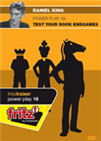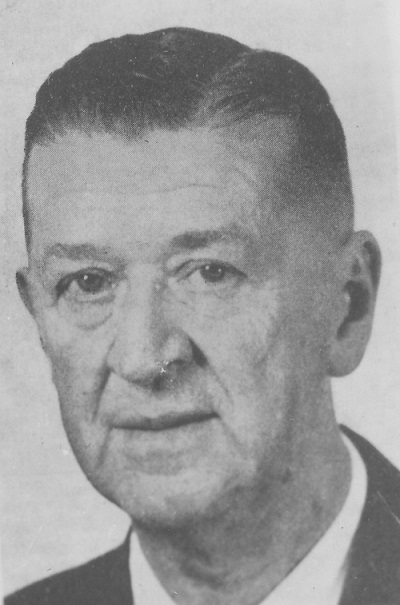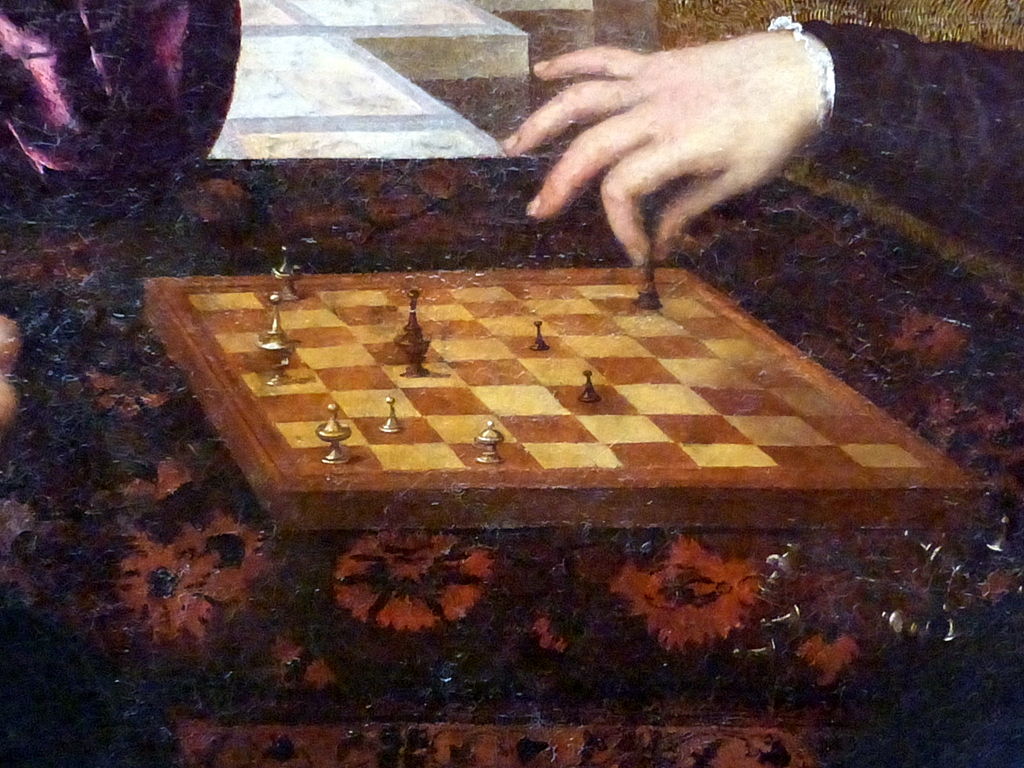To me, the name of an endgame studies composer is often connected with certain attributes or characteristics of his compositions. Studies of Grigoriev, for example, are connected with original and instructive pawn endgames of high artistic quality. It isn't without reason that the creative work of Grigoriev has been published in Dutch with the title "pionnenkunstenaar!” which literally means "pawn artist". Furthermore, I connect studies of Réti with clarity and originality, especially when there are few pieces on the board.[1]
In his collection of studies ”Endspielstudie zwischen Theorie und Artistik“[2] Jan van Reek Jan van Reek classifies those studies with few pieces as "miniatures". He fittingly writes about it: "The miniature enjoys immense appreciation as a classic and a source of joy. As a gem, it shows ideas in their purest form. Fine manoeuvers on an almost empty board please the eye and leave a deep impression." (p. 13, translation SH). We want to add here that such a definition of a miniature of course is not limited to studies, but also includes, for example, one or two-movers. A wonderful book with fantastic two-movers is Robert Lincoln's[3] “Fun with Chess Miniatures”. It contains “540 puzzles for Novice and Expert” in the form of “two-mover chess miniatures”.
It is no coincidence that the two most famous studies of Réti and Saavedra[4] are miniatures with four pieces each. In the same way, I also associate the name Isenegger with simplicity and clarity. Browsing through the collection of studies by J. Levitt and D. Friedgood “Secrets of Spectacular Chess”[5] I stumbled upon a study of this composer. Prior to speaking in more detail about this study, I want to make some remarks about Levitt and Friedgood's collection. We find the following assessment in the preface of said book: "In this book, John Levitt and David Friedgood tackle the problem of isolating those elements of the game which contribute to chess beauty." Those elements, after which studies are classified, are the following: "Paradox", "Depth", "Geometry" and "Flow". In the chapter about "Depth", the authors present the following study:
 Rules of thumb are the key to everything when you are having to set the correct course in a complex endgame. In this final DVD of his series on the endgame, our endgame specialist introduces you to the most important of these rules of thumb.
Rules of thumb are the key to everything when you are having to set the correct course in a complex endgame. In this final DVD of his series on the endgame, our endgame specialist introduces you to the most important of these rules of thumb.
About the given study, Levitt and Friedgood give the following instructive remarks: "If White simply pushes the pawn, Black promotes his straight after, and the game is drawn. Instead, White can win with the cute Ke2! This forces Black to play 1…Kh2, else White will be able to stop Black's pawn with Kf3, whilst his own is well beyond the reach of Black's king. Only now does White push his pawn, and we realize that this wins as it promotes on b8 with check." (Levitt and Friedgood, p. 61)
As the given position is an endgame study, it is to be assumed that the first move Ke2, honoured with an exclamation mark by Levitt and Friedgood, is the only winning move. Prior to resolving the question of whether this indeed is the case, I want to elaborate on two further authors who added the study by Isenegger into their collections. The first one is a classic in this field, the work by Harold M. Lommer titled "1357 End-Game Studies". The Isenegger study is pictured on page 3, and the solution given on page 119 runs as follows: "1.Ke2!; This move threatens 2.Kf3 forcing Black to play 2…Kh2, which allows the white Pawn to queen with check."
 As Lommer has given an exclamation mark to the first move, it can be assumed that he is also of the conception that the move Ke2 is the only winning move.
As Lommer has given an exclamation mark to the first move, it can be assumed that he is also of the conception that the move Ke2 is the only winning move.
Irving Chernev has also added this Isenegger study in his collection "200 Brilliant Endgames". He begins his examination with the introductory remark: "Simple endings are not always simple. In this one, the first move is decisive." He adds two exclamation marks to the first move, which is supposed to tell us this is the only solution. We follow the elaborations of Chernev: "1.Ke2!! The threat (after 1…g5) is 2.Kf3. Therefore, Black must move his King, but not to the g-file, which would block his Pawn. 1…Kh2 The point is that this move is forced. Now White can queen his Pawn with check! The continuation: 2.b4 g5 3.b5 g4 4.b6 g3 5.b7 g2 6.b8Q+ Kh1. If instead 6…Kh3 7.Kf2 wins the Pawn, or if 6…Kg1 7.Qg3 Kh1 and mate next move. 7.Qh8+ Kg1 8.Kf3 Kf1 9.Qa1 mate." (Chernev, p. 88)
Now, it is not difficult to recognize that after the first white move, 1.Ke2, indeed 1…Kh2 is forced (as all the previously named authors agreed upon), but White does not have to set his pawn — which is not threatened yet by the black king — immediately in motion. He can also attack the black pawn and play immediately 2.Kf3. This forces 2…Kh3, as otherwise the king runs towards the black g-pawn and captures it. Thus, 1.Ke2 enforces the opponent's move 1…Kh2, and 2.Kf3 enforces Kh3.
It follows that 1.Ke2 (as Chernev, Levitt and Friedgood as well as Lommer allege) isn't the only winning move, but 1. Kf2 is another fully equivalent solution. Interestingly, Levitt and Friedgood provide a question mark to this move: "Note that 1.Kf2? is a case of being hoist by one's own petard, as after 1.Kh2, Black's arrives on g3 with check, thus gaining time and promoting before White's." (Levitt and Friedgood, p. 61). Thereby, the authors allege that after the mentioned moves, 1.Kf2 Kh2, both parties immediately set their passed pawns in motion, leading to an advantage for Black, as his pawn on the g-file gives a check when it passes g3 on the way to its promotion square.
White, however, is not forced to immediately start up his pawn after 1.Kf2 Kh2, but prior to that he can advance his king into the direction of his opponent’s g-pawn. So there follows 2.Kf3 Kh3 3.Kf4 Kh4, after which the following position is reached.[6]
 The aim of this DVD is to provide you with the practical skills and knowledge that you will need to play a rook and pawn endgame. Based on his own playing experience, Grandmaster Daniel King reveals what is essential knowledge, saving you time in your studies. The Power Play series is suitable for anyone looking to improve their chess, but also provides ready-made lessons and exercises for a trainer.
The aim of this DVD is to provide you with the practical skills and knowledge that you will need to play a rook and pawn endgame. Based on his own playing experience, Grandmaster Daniel King reveals what is essential knowledge, saving you time in your studies. The Power Play series is suitable for anyone looking to improve their chess, but also provides ready-made lessons and exercises for a trainer.
Running time: 5 hours
After the continuation 4.b4 g5+ 5.Ke3 g4 6.b5 Kh3 7.b6 g3 8.b7 g2, White prevents the pawn promotion with 9.Kf2. If Black does not want to lose his pawn, he is forced to play 9…Kh2. Now, however, White promotes his pawn by playing 10.b8Q with check, and checkmates with his newborn queen on g3 or h8.
I believe that the second solution with the starting move 1.Kf2 has a higher instructive value. It is revealed that it is not just a pure pawn endgame but also an endgame of king and pawn against king and pawn, where the incorporation of the king into play has to be considered. As the famous Réti study has shown, the king not only has to be manoeuvred in a way that it supports his pawn, but it also has to be moved in a way that, if possible, delays or prevents the opposing king from coming closer.[7]
The book “Let me ask you, do you know...?” by Karaklajic also includes the Isenegger study on page 10, citing L’Echiquier de Paris from 1964 as a source and also giving the move 1.Kf2.
In fact, the second solution is shown also in the database of Harold van der Heijden, but it was already mentioned in the original source. Josef Moravec managed to find the idea as well, as is evident by a study in Ceske Slovo 1940 that shows similar play as after 1.Kf2 (wKd2 Ph2, bKb2 Pc7). Grigoriev himself elaborated on the idea again in 1954 (wKe1 Ph2 bKa2 Pc7) in a very similar setting to the one by Moravec, leading to said study after two moves.

Samuel Iseneger | Photo: Archiv Bondarenko
Translation from German: Siegfried Hornecker
Notes by Siegfried Hornecker
[1] It is noteworthy that both Grigoriev and Réti also were practical player of the highest level.
[2] Roughly meaning: “The endgame study between theory and art.” ISBN: 3-929291-01-0. According to the review in EG 116 it is a “handy hard-cover volume” of five of Jan van Reek’s earlier assemblies, translated into German.
[3] The American composer Robert “Bob” Lincoln only recently died on 19 October 2017 at the age of 79. He composed over 6,000 chess problems and wrote three books.
[5] The book also includes games and problems similarly.
[6] The play is the same as in N.D. Grigoriev, Isvestia, 15 February 1928: Kc2 Pg3, Ka2 Pb6. White wins.
[7] The late Mark Dvoretzky called this a “bodycheck”.


















 As Lommer has given an exclamation mark to the first move, it can be assumed that he is also of the conception that the move Ke2 is the only winning move.
As Lommer has given an exclamation mark to the first move, it can be assumed that he is also of the conception that the move Ke2 is the only winning move.





